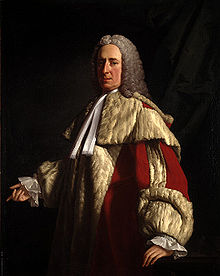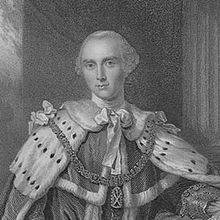- Archibald Campbell, 3. Duke of Argyll
-
Archibald Campbell, 3. Duke of Argyll, besser bekannt als Archibald Campbell, 1. Earl of Ilay (auch Islay) KT KG, PC (* 1. Juni 1682 in Petersham, Surrey; † 15. April 1761 in London) war ein schottischer Aristokrat, Richter, Politiker und Soldat.
Inhaltsverzeichnis
Leben
Archibald Campbell war ein Sohn des Archibald Campbell, 1. Duke of Argyll (1658–1703) und dessen Gemahlin Lady Elizabeth Tollemache (1659–1735). Er folgte seinem Bruder, John Campbell, 2. Duke of Argyll, 1743 – kurz vor der Jakobitischen Erhebung (1745) – als Duke of Argyll und Oberhaupt des Campbell-Clans.
Nach kurzer militärischer Laufbahn ging Archibald Campbell in die Politik und wurde 1706 einer der Kommissare für den Act of Union 1707. In der Schlacht von Sherriffmuir (1715) wurde er schwer verletzt. Nachdem man für ihn den Titel des Earl of Ilay geschaffen hatte, wurde er zu einem von 16 Vertretern der Peers von Schottland (Representative Peer) im House of Lords gewählt. Während der Amtszeiten von Sir Robert Walpole (1721–1742), Spencer Compton, 1. Earl of Wilmington (1742–1743) und Henry Pelham (1743–1754) beherrschte er, zum einen durch die Macht der Campbells, zum andern mit Unterstützung der Regierung, die Politik in Schottland.
Lord Ilay war einer der Begründer der Royal Bank of Scotland (RBS), die im Jahr 1727 durch königliches Dekret gegründet wurde, und fungierte als erster Gouverneur der Bank. Sein Porträt – basierend auf einem Gemälde von Allan Ramsay – erschien auf der Vorderseite aller Royal Bank of Scotland-Banknoten und als Wasserzeichen; erst im Jahr 1987 wurden sie neu gestaltet.
Archibald Campbell baute das Stammschloss der Campbells Inveraray Castle wieder auf und gilt als Begründer des Ortes Inveraray. Der Herzog war ein begeisterter Botaniker und ließ eine große Anzahl von exotischen Pflanzen und Bäumen importieren. Horace Walpole gab ihm sogar den Spitznamen Treemonger. Nach seinem Tod erbte sein Neffe John Stuart, 3. Earl of Bute [1] (1713–1792) seinen großen Garten; dieser war der Grundstock der späteren berühmten Royal Botanic Gardens in Kew. Sie wurden von der Prinzessin Augusta von Sachsen-Gotha-Altenburg, der Witwe Friedrich Ludwigs, des Prince of Wales, deutlich erweitert. Ihm zu Ehren wurde der The Duke of Argyll's Tea Tree (Gemeiner Bocksdorn), ein importierter Strauch, nach ihm benannt.
Archibald Campbell, 3. Duke of Argyll, starb ohne legale Nachkommen, der Titel ging an seinen Cousin John Campbell (1693–1770) über.
Name in verschiedenen Lebensphasen
- 1682–1703 Sir Archibald Campbell
- 1703–1706 Lord Archibald Campbell
- 1706–1743 Archibald Campbell, 1. Earl of Ilay
- 1743-1761 Archibald Campbell, 3. Duke of Argyll
Ämter und Auszeichnungen
- 1710–1761 Lord President of the Court of Session
- 1711 Privy Counsellor
- 1714–1716 Lord Clerk Register
- 1721–1733 Lord Keeper of the Privy Seal of Scotland
- 1733–1761 Lord Keeper of the Great Seal of Scotland
- 1737–1761 Lord Lieutenant of Haddington
Weblinks
Einzelnachweise
- ↑ Archibald Campbell, 3. Duke of Argyll in der Notable Names Database (englisch)
Vorgänger Amt Nachfolger John Campbell Duke of Argyll
1743–1761John Campbell
Wikimedia Foundation.


